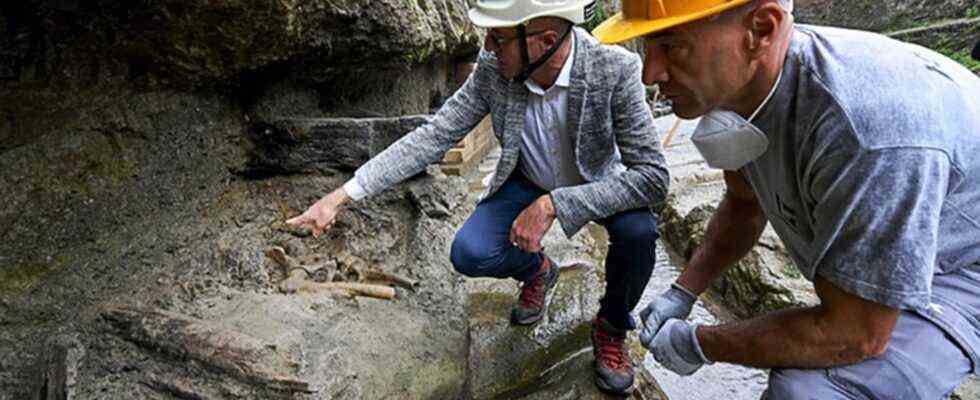The “Last Refugee” shows the drama of the eruption of Vesuvius. The man had almost made it to the lifeboats when he was knocked down by a beam. The body of a rescue mission officer was previously found nearby.
The “last refugee” of the Vesuvius eruption catastrophe was discovered on the beach in the former city of Herculaneum. This is a new excavation; around 300 people seeking protection were discovered at the same site 25 years ago. They all hoped to have already saved themselves. Many refugees waited in the fishermen’s huts on the beach in the old town of Herculaneum. The lifeboats of the imperial fleet landed on the bank that morning, but many refugees did not make it there. Archaeologists believe this man was between 40 and 45 years old.
Last minute death
But it is conceivable that he was one of the soldiers who swarmed out on the beach to rescue the people. “He could have been a soldier with a lifeboat trying to get a group of people out to sea,” said Francesco Sirano, director of the archaeological sites at Herculaneum. Or one of the refugees who had left the group and the shelter to reach the sea in the hope of being able to board one of the lifeboats.
The Romans were not prudish – wedding carriages were decorated with sex scenes
7 images
Since no equipment of a soldier has yet been found, the dead man is called the “last refugee”. Since he was alone, he may have been the one in a group that didn’t make it to the boats. It was found at the foot of the very high lava stone wall that now closes the ancient sea front. He was lying with his head back towards the sea and was surrounded by heavy, charred wood, even a roof beam that had injured his head. The bones look bright red, says Sirano. “It is the impression left by the victim’s blood,” said the archaeologist. This is the result of a very special combustion process that was caused in Herculaneum by the flow of magma, ash and gas from Vesuvius.
No rescue from the gas tongues
Vesuvius buried Pompeii and the nearby cities of Oplontis, Stabiae and Herculaneum under ash, mud and boulders on October 24, 79 AD. Many of the victims were covered in ashes, leaving behind the characteristic prints that have lasted for thousands of years. But most of them died from hot tongues of gas that spread at lightning speed. There was no escape from them. Such gas clouds reach over 700 kilometers per hour and heat up to 1000 degrees. This “hell on earth” would be swept over people in a few minutes, according to Sirano. It devoured most of the city and killed people and animals with such heat that the corpses evaporated (evaporating blood and exploding skulls – so cruelly did the victims of Vesuvius die).
Navy rescue operation
Only recently an elite Roman soldier was discovered about 20 meters away on the beach. Strictly speaking, the remains had been dug up earlier, but only later found the correct conclusions from the finds next to the dead body. “When I arrived at Herculaneum in 2017, I realized that a lot of research was going into the skeletons, but no one thought of analyzing the tools that were found alongside,” says Sirano. In contrast to the other skeletons lying on the beach and the huts there, the man was a military man. He carried an ornate leather belt, an ornate dagger, and a sword with an iron handle. Analyzes showed that the belt was decorated with images of a lion and a cherub and the scabbard of the sword showed the image of an oval shield.
Sirano assumes, mainly because of the image of the shield, that the man was a member of the Praetorian Guard. “Praetorians wore oval shields,” explains Sirano. Legionnaires rectangular. “He could be an officer in the fleet that took part in the rescue mission that Pliny the Elder started to help the people in the towns and villas that are on this part of the Bay of Naples,” said Sirano. The bag with a full monthly wage suggests that Pliny motivated his men by issuing a special payment before the dangerous mission. Smaller chopping and digging tools were found next to the body.
Pliny the Elder, was a scholar of natural science and at the time the commanding officer of the Roman naval base at Misenum on the Gulf of Naples. And anything but a hero. Pliny was 55 years old, overweight, asthmatic and had no maritime experience, yet he commanded the most important navy in the Roman Empire. The story of the outbreak was passed down through the accounts of his nephew, Pliny the Younger. Accordingly, the uncle was worried when he saw a strange cloud rising from Vesuvius. He ordered a galley to get ready to sail over and investigate.
Heroic death of a scholar
Shortly afterwards he received a message from his friend Rectina, who begged him to rescue her from her villa at the foot of the mountain. “He changed his plans, and what he had begun in the spirit of investigation he accomplished like a hero. He gave the order to launch the warships and went on board himself, with the intention of many other people besides Rectina To bring help, because this beautiful stretch of coast was densely populated. “
Pliny took the largest ships in his fleet to cross the bay. The complete destruction of Pompeii lasted three days, those who left the city immediately or were in transit survived. Anyone who hesitated at the beginning could not escape later. When the huge ships arrived with their 232 rowers, the situation was already catastrophic. “Ash was already falling, getting hotter and thicker the closer the ships came, followed by chunks of pumice and blackened stones that were charred and burned by the flames. For a moment my uncle pondered whether he should turn back, but as the helmsman.” advised to do so, he declined. “
Pliny could not dock in Pompeii, his ships docked in Stabiae. After the rain of pumice stone and ash, hot tongues of gas raged at midnight, first through Herculaneum and then in the morning through Pompeii. They killed everyone who stayed in town. Presumably the “last refugee” and the Praetorian died. The unsportsmanlike Pliny himself set an example for his men and ended up on the beach with them. That was where he too found death that morning.



